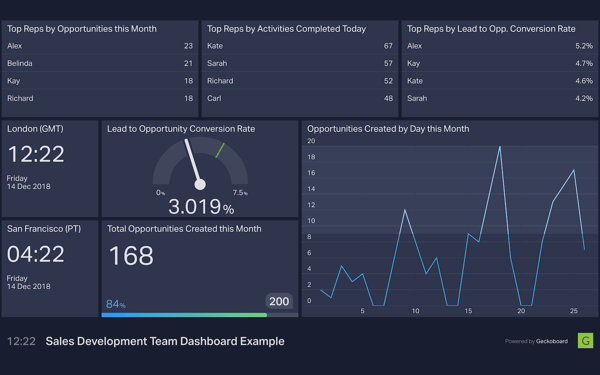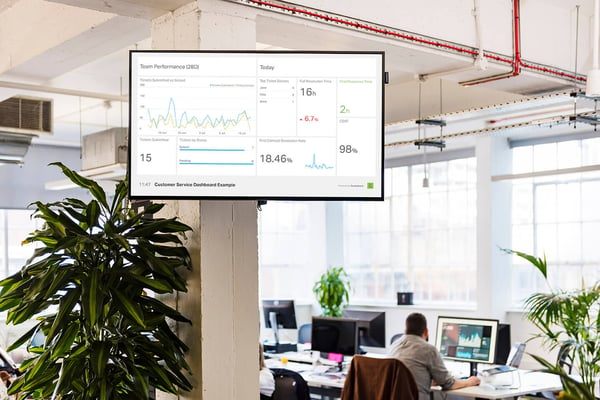Most managers are on a constant lookout for tools and tweaks that make their team’s work easier and more efficient.
But to improve their overall performance, your team needs something more substantial than tweaks. They need an easy way to measure their performance.
To do this right now, they probably have to dig into several time-consuming tools or ask someone else for their performance data. Or maybe they have to wait until the end of the week or month for a report.
When key data isn’t readily available, your team can’t react as fast as they want to. They may also lose sight of the things that really matter to your company. This can lead to all sorts of other challenges, from people working in silos to poor motivation and wasted resources.
To tackle these challenges, a dashboard offers a fresh way of doing things. It also works alongside existing approaches like OKRs and KPIs. Above all, it can help your team feel confident and ready to take action. We’ll explain exactly how it helps in this article, but let’s first overview what we mean by a dashboard.
What is a dashboard?
According to Stephen Few, a dashboard is a visual display of the most important information needed to achieve one or more objectives, consolidated and arranged on a single screen so the information can be monitored at a glance.
Here’s what a well-designed dashboard should look like:

A dashboard makes your team’s most important data visible, understandable, and actionable so that they can measure and improve their performance. Let's see five key reasons why dashboards are the go-to hardware your team needs.
1. It makes their key data accessible
Your team often has to go through multiple tools, reports, or other people to track their performance data. But a dashboard allows your team to see their key data in one place, whenever they need it.
A dashboard also simplifies your team’s data and removes the need for analysis. For example, with tools like Google Analytics, there’s a rabbit warren of data your team could look at. Using dashboard software to create a well-designed dashboard gives your team the one set of numbers they actually need, and presents them in such a simple way they can understand them at a glance.
Performance-wise, this means they can devote their energy to moving the numbers rather than debating what the numbers mean.
2. It focuses them on important objectives
When your team is taking care of day-to-day tasks, they can get distracted and lose sight of what’s important. A dashboard avoids this by making any KPIs (key performance indicators) or meaningful and important objectives clearly visible for your team. This helps them focus on work that will actually make a difference. Also, when priorities change, a dashboard makes new objectives clear to keep your team on course.
3. It keeps them motivated
Clearly displaying objectives gives your team something to strive for. It shows them how they can make a difference to the company, and inspires them to take ownership. And this should hopefully encourage their natural interest and intrinsic motivation.
On top of this, most dashboards let you name-check star performers and add leaderboards. This is particularly good for sales teams who tend to be motivated by healthy competition and praise (extrinsic motivation).

4. It shows their impact
When your team is trying out new ideas to achieve their goals, a dashboard clearly shows their impact. For example, a marketing team could see that the number of sign-ups spiked after they introduced a new ad campaign.
Meanwhile, some dashboards have specially designed visualizations that give a satisfying sense of progress, like this one:

5. It inspires them to take action
The ultimate aim of a dashboard is to help your team take action so they can improve their performance. But to achieve this, you really need TV dashboards. These go on a big screen in front of your team and give real-time feedback on how things are going. They also make problems and opportunities impossible to miss.
For example, imagine your customer support team is taking care of tickets. With a TV dashboard, they can instantly spot bottlenecks and respond to customer queries before they get out of hand. Whereas if they didn’t have a dashboard – or had to keep refreshing a dashboard in one of their tabs – they might miss the problem or spot it too late.

Likewise, if your marketing team needs to keep a close eye on paid spending, a TV dashboard would instantly highlight opportunities so your team could decide to increase the budget on a particular set of keywords.
Why a TV dashboard is even better for sparking action
A TV dashboard (also called a wallboard) isn’t just a regular dashboard thrown on a TV. It’s designed specially for a TV screen, with clear visualizations that can be read at a glance, like this:

And unlike a regular dashboard, which you’d probably share with your team via a link or fire up in meetings, a dashboard is always visible, extra clear, and distraction free. Let’s dive into these reasons a bit more.
Always visible
If you share your team’s dashboard via a link, it can get lost in their emails or browser tabs, and important information may get overlooked – just as it did with reports. But a prominent TV dashboard ensures that key goals and information are front of mind. And this means your team can take action before it’s too late
Extra clear
Not all dashboards are easy on the eye. Good TV dashboards are designed specially for TV with clean visualizations that can be understood at a glance. This means your team can quickly see what they need to do while keeping an eye on things without disrupting their workflow.
Distraction-free
Some dashboards are interactive so you can expand the data and get extra detail. This is great for in-depth analysis, but if you want your dashboard to spark immediate action you don’t want any distractions. This is another reason why a TV dashboard is better; it’s a limited space so it discourages you from adding unnecessary details. These qualities, particular to the medium, make a TV dashboard the best way to spark action.
How do you actually make a dashboard?
Now you know the benefits of a dashboard, you’ll probably want to build your own. A quick and no-frills way to do this is by creating one in Google Sheets. Or you can use specialist dashboard-software tools. These make it really easy to gather metrics from all your favourite tools, build a great-looking dashboard that can be understood at a glance, and share it with your team.
Conclusion
Using a dashboard for your team is universally beneficial. From keeping everyone on the same page to having all data easily accessible and visible at a given moment, dashboards are the way to go to amplify your team’s success.
Ready to get started with putting your company's data for all of your employees to see? Check out the best data visualization software on the market today to make the best choice for your needs!

 by Kade Dalton
by Kade Dalton
 by Erin Wagner
by Erin Wagner
 by Connie Benton
by Connie Benton